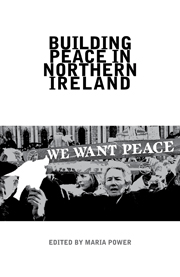Book contents
- Frontmatter
- Contents
- Acknowledgements
- Contributors
- 1 Introduction: Peacebuilding in Northern Ireland
- 2 Understanding the Role of Non-aligned Civil Society in Peacebuilding in Northern Ireland: Towards a Fresh Approach
- 3 The Role of Civil Society in Promoting Peace in Northern Ireland
- 4 The Contribution of Integrated Schools to Peacebuilding in Northern Ireland
- 5 Providing a Prophetic Voice? Churches and Peacebuilding, 1968–2005
- 6 ‘Peace Women’, Gender and Peacebuilding in Northern Ireland: From Reconciliation and Political Inclusion to Human Rights and Human Security
- 7 Encumbered by Data: Understanding Politically Motivated Former Prisoners and the Transition to Peace in Northern Ireland
- 8 Loyalism and Peacebuilding in the 2000s
- 9 Civil Society, the State and Conflict Transformation in the Nationalist Community
- 10 Examining the Peacebuilding Policy Framework of the Irish and British Governments
- 11 Building Peace and Crossing Borders: The North/South Dimension of Reconciliation
- 12 Peace Dividends: The Role of External Aid in Peacebuilding
- Index
1 - Introduction: Peacebuilding in Northern Ireland
- Frontmatter
- Contents
- Acknowledgements
- Contributors
- 1 Introduction: Peacebuilding in Northern Ireland
- 2 Understanding the Role of Non-aligned Civil Society in Peacebuilding in Northern Ireland: Towards a Fresh Approach
- 3 The Role of Civil Society in Promoting Peace in Northern Ireland
- 4 The Contribution of Integrated Schools to Peacebuilding in Northern Ireland
- 5 Providing a Prophetic Voice? Churches and Peacebuilding, 1968–2005
- 6 ‘Peace Women’, Gender and Peacebuilding in Northern Ireland: From Reconciliation and Political Inclusion to Human Rights and Human Security
- 7 Encumbered by Data: Understanding Politically Motivated Former Prisoners and the Transition to Peace in Northern Ireland
- 8 Loyalism and Peacebuilding in the 2000s
- 9 Civil Society, the State and Conflict Transformation in the Nationalist Community
- 10 Examining the Peacebuilding Policy Framework of the Irish and British Governments
- 11 Building Peace and Crossing Borders: The North/South Dimension of Reconciliation
- 12 Peace Dividends: The Role of External Aid in Peacebuilding
- Index
Summary
When the Good Friday or Belfast Agreement was signed in 1998, those involved believed that they ‘were finally able to bring about peace in Northern Ireland’. The process of implementing the accord and resolving tensions between the various political parties began and on 7 May 2007, the Democratic Unionist Party and Sinn Féin entered government together. Nine years after the Agreement was signed, this ‘historic’ day was heralded by the British and Irish political classes and the media as the end of the conflict in Northern Ireland. As noted by Blair in his description of that day, this achievement signalled the ‘normalisation’ of the region's politics to the British and Irish governments through a movement away from division:
Every time we set foot in Northern Ireland there were protests … always showing how divided the politics of Northern Ireland was from that anywhere else. That day for the first time there was a protest not about Northern Ireland, but about Iraq. When I saw it, I felt that Northern Ireland had just rejoined the rest of the world.
The British and Irish governments believed that the Peace Process, with its focus on elite political settlement, was complete and it was expected that the rest of society would follow the example set by their leaders and overcome divisions to work together.
However, the resolution of conflict is not simple and, as will be demonstrated later in this introduction, Northern Ireland is not peaceful.
- Type
- Chapter
- Information
- Building Peace in Northern Ireland , pp. 1 - 17Publisher: Liverpool University PressPrint publication year: 2011



